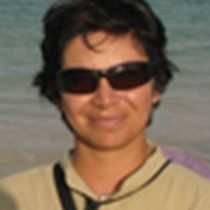Isabela & Fernandina Islands
Isabela Island is the largest island in the archipelago; it has a little more than fifty percent of the total land area of Galápagos. It also has five major and active volcanoes, and the remains of a sixth volcano known as Volcan Ecuador. This morning we sailed along the coast of northern Isabela looking for sea birds and marine mammals. In the distance we could see the spouts of elusive Bryde’s whales. Twice the whales surfaced quite close to the ship and we could even hear them exhaling! We also found one of the island’s most endangered sea bird, the Galápagos petrel. Fortunately, and thanks to the efforts of the National Park, these ground nesting petrels that were decimated by introduced predators are slowly coming back from the verge of extinction. We found several of them this morning, gracefully flying over the gorgeous, calm ocean close to our ship.
After breakfast, we crossed the Equator line (for the second time) and sailed along at the base of the collapsed caldera of Ecuador volcano. We anchored, launched our Zodiacs and went for a ride along the spectacular coastline at Punta Vicente Roca. Here we observed lots of Pacific green sea turtles (and many of them were feeding on sea jellies!), penguins, flightless cormorants, sea lions, and several species of seabirds perched on the cliffs. One of the things that particularly drew our attention was the geology of this place: the brown, red and dark colors of the lava rocks, the columnar, volcanic sills, the tuff piled on basaltic lava flows - this is nature’s work of art.
We hauled up anchor right after lunch and had a smooth navigation to Fernandina Island, the youngest of the archipelago. As we set foot on the island we were greeted by the official welcome committee: large, stately Galápagos marine iguanas and curious, rowdy sea lion pups. We walked over relatively young black lava flows and were surrounded by wildlife all afternoon at Punta Espinoza. There were large numbers of marine iguanas, and they were just as black as the lava they were resting upon. Fernandina is the most pristine island in the archipelago and looks now the way all the islands did millions of years ago.
As the day came to an end, and we headed towards the ship for our evening recaps, we witnessed a magnificent sunset. Later, while we enjoyed cocktails in the lounge, Naturalist Daniel showed us some of the smallest creatures that inhabit the oceans using our video microscope. These incredibly interesting and varied planktons, so rarely seen because they are so tiny, are a vital part of life on our planet Earth.
Isabela Island is the largest island in the archipelago; it has a little more than fifty percent of the total land area of Galápagos. It also has five major and active volcanoes, and the remains of a sixth volcano known as Volcan Ecuador. This morning we sailed along the coast of northern Isabela looking for sea birds and marine mammals. In the distance we could see the spouts of elusive Bryde’s whales. Twice the whales surfaced quite close to the ship and we could even hear them exhaling! We also found one of the island’s most endangered sea bird, the Galápagos petrel. Fortunately, and thanks to the efforts of the National Park, these ground nesting petrels that were decimated by introduced predators are slowly coming back from the verge of extinction. We found several of them this morning, gracefully flying over the gorgeous, calm ocean close to our ship.
After breakfast, we crossed the Equator line (for the second time) and sailed along at the base of the collapsed caldera of Ecuador volcano. We anchored, launched our Zodiacs and went for a ride along the spectacular coastline at Punta Vicente Roca. Here we observed lots of Pacific green sea turtles (and many of them were feeding on sea jellies!), penguins, flightless cormorants, sea lions, and several species of seabirds perched on the cliffs. One of the things that particularly drew our attention was the geology of this place: the brown, red and dark colors of the lava rocks, the columnar, volcanic sills, the tuff piled on basaltic lava flows - this is nature’s work of art.
We hauled up anchor right after lunch and had a smooth navigation to Fernandina Island, the youngest of the archipelago. As we set foot on the island we were greeted by the official welcome committee: large, stately Galápagos marine iguanas and curious, rowdy sea lion pups. We walked over relatively young black lava flows and were surrounded by wildlife all afternoon at Punta Espinoza. There were large numbers of marine iguanas, and they were just as black as the lava they were resting upon. Fernandina is the most pristine island in the archipelago and looks now the way all the islands did millions of years ago.
As the day came to an end, and we headed towards the ship for our evening recaps, we witnessed a magnificent sunset. Later, while we enjoyed cocktails in the lounge, Naturalist Daniel showed us some of the smallest creatures that inhabit the oceans using our video microscope. These incredibly interesting and varied planktons, so rarely seen because they are so tiny, are a vital part of life on our planet Earth.




